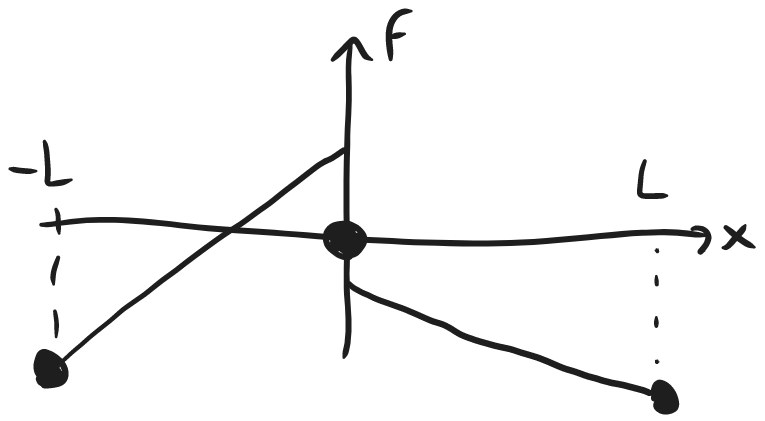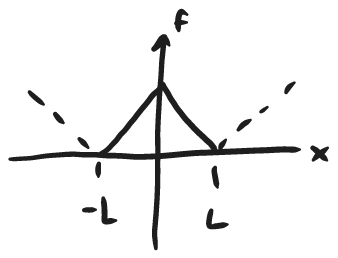#fourier
Remember the heat flow equation? We obtained that it's solution could be expressed in the form:
$$\sum_{n=1}^\infty c_{n}\sin\left( \frac{n\pi x}{L} \right)\quad\text{for}\quad0\leq x\leq L$$
But what is $c_{n}$? They are the coefficients of a Fourier transform. We want to develop a way to compute them.
Let's derive how to compute the coefficients of a Fourier transform. (feel free to skip to the end)
$f(x)=\sum_{n=1}^\infty b_{n}\sin\left( \frac{n\pi x}{L} \right)$ where $L$ is length of the rod
This is a Fourier series: it's a more general form of what we have above.
$f(x)=\frac{a_{0}}{2}+\sum_{n=1}^\infty\left( a_{n}\cos\left( \frac{n\pi x}{L} \right) + b_{n}\sin\left( \frac{n\pi x}{L}\right) \right)$
$x \in [-L,L]$
It converges to $f(x)$ almost everywhere (convergence will be discussed below)
Has a lot of benefits over Taylor series. $f(x)$ doesn't have to be infinitely differentiable (analytic)
$f(x)$ can even have jump discontinuities
Let's assume the equation is true when $x \in [-L,L]$
Integrate both sides, it will tell us the DC offset:
$\int _{-L} ^L f(x) \, dx=\int _{-L}^L \frac{a_{0}}{2} \, dx+\int _{-L}^L (\text{put summation here}) \, dx$
$\int _{-L}^L \cos\left( \frac{n\pi x}{L} \right) \, dx=\frac{L}{n\pi}\sin\left( \frac{n\pi x}{L} \right)|_{-L}^L=0$
same for $\int _{-L}^L \sin\left( \frac{n\pi x}{L} \right)\, dx=0$ (it equals 0)
so
$\int _{-L} ^L f(x) \, dx=\int _{-L}^L \frac{a_{0}}{2} \, dx+\int _{-L}^L0 \, dx$
$\int _{-L} ^L f(x) \, dx=a_{0}L$
$a_{0}=\frac{1}{L}\int _{-L}^{L} f(x) \, dx$
Now let's multiply both sides by $\cos\left( \frac{m\pi x}{L} \right)$ and integrate both sides, this will tell us the $\cos$ components:
$\int _{-L}^L f(x)\cos\left( \frac{m\pi x}{L} \right)\, dx=\frac{a_{0}}{2}\cancelto{ 0 }{ \int _{-L}^L \cos\left( \frac{m\pi x}{L} \right) \, dx }+\sum_{n=1}^\infty\left( a_{n}\int _{-L}^L\cos\left( \frac{n\pi x}{L} \right)\cos\left( \frac{m\pi x}{L} \right) \, dx +b_{n}\int _{-L}^L \sin\left( \frac{n\pi x}{L} \right)\cos\left( \frac{m\pi x}{L} \right)\right) \, dx$
use trig identities (will be provided on exam):
$\cos(\alpha)\cos(\beta)=\frac{1}{2}(\cos(\alpha-\beta)+\cos(\alpha+\beta))$
$\sin(\alpha)\cos(\beta)=\frac{1}{2}(\sin(\alpha+\beta)+\sin(\alpha-\beta))$
$\sin(\alpha)\sin(\beta)=\frac{1}{2}(\cos(\alpha-\beta)-\cos(\alpha+\beta))$
$\int _{-L}^L \cos \frac{n\pi x}{L}\cos \frac{m\pi x}{L}\, dx=\frac{1}{2}(\int _{-L}^L \left( \cos(\frac{(n-m)\pi x}{L} )+\cancelto{ 0 }{ \cos(\frac{(n+m)\pi x}{L} })\right)dx$
$= \begin{cases}0 & n\ne m \\L & n=m\end{cases}$
$\int _{-L}^L \sin \frac{n\pi x}{L}\cos \frac{m\pi x}{L} \, dx=\int _{-L}^L \text{odd}\, dx=0$
so:
$\int _{-L} ^L f(x)\cos\left( \frac{m\pi x}{L} \right)\, dx=a_{m}L$
Similarly can be done for when multiplying both sides by $\sin\left( \frac{m\pi x}{L} \right)$ and integrating both sides to find the $\sin$ coefficients:
$\int _{-L}^L f(x)\sin\left( \frac{m\pi x}{L} \right)\, dx=\frac{a_{0}}{2}\cancelto{ 0 }{ \int _{-L}^L \sin\left( \frac{m\pi x}{L} \right) \, dx }+\sum_{n=1}^\infty\left( a_{n}\cancelto{ \text{odd} }{ \int _{-L}^L\cos\left( \frac{n\pi x}{L} \right)\sin\left( \frac{m\pi x}{L} \right) } \, dx +b_{n}\int _{-L}^L \sin\left( \frac{n\pi x}{L} \right)\sin\left( \frac{m\pi x}{L} \right)\right) \, dx$
$\int _{-L} ^L \sin\left( \frac{n\pi x}{L} \right)\sin\left( \frac{m\pi x}{L} \right) \, dx=\frac{1}{2}\int_{-L}^L \cos\left(\frac{(n-m)\pi x}{L} \right)-\cos\left( \frac{(n+m)\pi x}{L} \right)dx$
$=\begin{cases}0, & n\ne m \\L, & n=m\end{cases}$
so:
$\int _{-L} ^L f(x)\sin\left( \frac{m\pi x}{L} \right)\, dx=b_{m}L$
In conclusion:
$$a_{m}=\frac{1}{L}\int _{-L}^L f(x)\cos \frac{m\pi x}{L} \, dx \quad\text{valid for all }m=0,1,2,\dots$$
$$b_{m}=\frac{1}{L}\int _{-L}^L f(x)\sin \frac{m\pi x}{L} \, dx=b_{m} \quad m=1,2,\dots$$
Now we know how to compute the coefficients for Fourier series!
properties:
for functions $f$, $g$, If $\int _{-L}^Lf(x)g(x) \, dx=\begin{cases}0 & f\ne g \\L & f=g \end{cases}$
then $f, g$ are orthogonal
the Fourier expansion is called an ortho normal expansion, Taylor is not orthonormal.
#end of lec 28
#start of lec 29
Last lecture we derived how to find the coefficients of a Fourier series.
$f(x)=\frac{a_{0}}{2}+\sum_{n=1}^\infty\left( a_{n}\cos\left( \frac{n\pi x}{L} \right) + b_{n}\sin\left( \frac{n\pi x}{L}\right) \right)$
$x \in [-L,L]$
### 1st convergence theorem:
If $f$ and $f'$ are piecewise continuous on $[-L,L]$, then the Fourier series converges to:
$\frac{1}{2}(f(x^-)+f(x^+))$ for all $x \in (-L,L)$
and on $x=\pm L$ the Fourier series converges to $\frac{1}{2}(f(-L^+)+f(L^-))$

Recall the definition of piecewise continuous: $f(t)$ is piecewise continuous on an interval $I$ if $f(t)$ is continuous on $I$, except possibly at a finite number of points of jump discontinuity (horizontal asymptotes not allowed).
### 2nd Convergence theorem (uniform convergence):
If $f(x)$ is continuous on $(-\infty,\infty)$ and $2L$ periodic and if $f'$ is piecewise continuous on $[-L,L]$, then its Fourier series converges to $f(x)$ everywhere (i.e., the Fourier series converges uniformly).

#ex #fourier
Let's compute the Fourier transform of:
$$f(x)=\begin{cases}1, & -\pi\leq x\leq 0 \\x, & 0Don't be a silly goose and try changing the bounds by removing that 2 in the front. If you did, you'd also have to change $\sin(x)$ to $\bar{f}$ which is $abs(\sin(x))$ and then you're integrating $a_{n}=\frac{1}{\pi}\int _{-\pi}^\pi |\sin(x)|\cos(nx)\, dx$ which is even$\times$even.
Use trig identity: (by the way the identities will be provided in the final exam.)
$=\frac{2}{\pi} \frac{1}{2}\int _{0}^\pi \left[\sin((1-n)x)+\sin((n+1)x)\right]\, dx$
Integrating gives you:
$\frac{1}{\pi}( \frac{-1}{1-n}\underbrace{ \cos((1-n)x)|_{0}^\pi }_{ (-1)^{n+1}-1 } +\frac{-1}{n+1}\underbrace{ \cos((n+1)x)|_{0}^\pi }_{ (-1)^{n+1}-1 })$
$a_{n}=-\frac{1}{\pi} \frac{1}{n+1}(-1)^{n+1}+\frac{1}{\pi} \frac{1}{n+1}+\frac{1}{\pi} \frac{1}{-(1-n)}(-1)^{n+1}+\frac{1}{\pi} \frac{1}{1-n}$
$a_{n}=-\frac{1}{\pi} \frac{1}{n+1} (-1)^{n+1}+\frac{1}{\pi} \frac{1}{n+1}+\frac{1}{\pi} \frac{1}{n-1}(-1)^{n-1}-\frac{1}{\pi} \frac{1}{n-1}$
Assuming that $n\ne0,1$. (note: $n=-1$ is a non-issue since negative coefficients are never considered when taking a Fourier transform.)
So what is $a_{0}, a_{1}$?
$a_{0}=\frac{2}{\pi}\int _{0}^\pi \sin(x) \, dx=\frac{4}{\pi}$
$a_{1}=\frac{2}{\pi}\int _{0}^\pi \sin(x)\cos(x) \, dx=\frac{1}{\pi}\int _{0}^\pi \sin(2x)\, dx=0$
"zero is a very very special number it took humanity many numbers of years to invent zero" referring to when dividing by 0.
Additionally we know that the terms cancel when:
$a_{2k-1}=0$ for $k=1,2,\dots$
$a_{2k}=\frac{2}{\pi} \frac{1}{2k+1}-\frac{2}{\pi} \frac{1}{2k-1}$ for $k=1,2,\dots$
then:
$$\bar{f}(x)=\frac{2}{\pi}+\frac{2}{\pi}\sum_{k=1}^\infty\left( \frac{1}{2k+1}-\frac{1}{2k-1} \right)\cos(2k\pi x)$$
Even with 10 terms, we get a pretty good approximation:

Here's a little script I wrote to generate an audible waveform of this Fourier series!
Number of harmonics:
Frequency:
We have prepared ourselves now, now we start solving PDE's. He's encouraging us to attend the lectures in these last two weeks. He's making it sound like PDE's are hard.